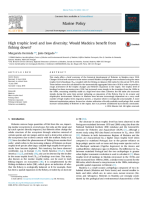High trophic level and low diversity: Would Madeira benefit from fishing down?

This study offers a brief overview of the historical development of fisheries in Madeira since 1938. Changes in food web structure in the waters around Madeira archipelago were evaluated using the mean trophic level of landings (TLm) coupled with the Fishing-in-Balance (FiB) index for the period 1979–2014. These indices were also calculated for the taxonomically aggregated data since 1938 in order to provide a rough assessment of the trophic changes and fisheries expansion in the region.
The trophic level of landings has been increasing since 1938, but increased more steeply in the transition from the 1980s to the 1990s, remaining relatively stable at a high level since then. Likewise, the FiB index also increased steeply during the same time period, indicating an expansion of the fishery.
Due to its oceanic and oligotrophic environment, fisheries in Madeira have become increasingly dependent on a very small number of high trophic level, migratory species, a situation which is ecologically unsustainable. A more balanced exploitation pattern, focused on a better utilization of locally available small pelagic fish, would increase sustainability of fisheries in the region, but is at present conditioned by economic constraints.







